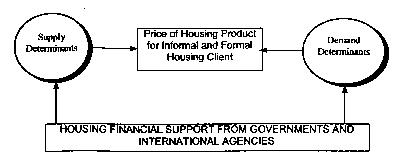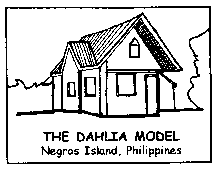 characteristics of the low
income groups have contributed greatly to the inaccessibility for this basic
human need – housing .
characteristics of the low
income groups have contributed greatly to the inaccessibility for this basic
human need – housing .|
Informal and Social
Housing: The significant role of Technology and Management –
experiences from the Negros Island, Philippines Billy Tusalem |
The
housing back log of 4.2 million units is a cause of concern to many Filipinos.
Majority of the households without shelter come from low income groups in urban
areas. The usual reasons being posed for this situation is that the informal
sector of our society characterized by irregularity of income and low savings,
are the groups with no access to financing for the acquisition of house and lot.
The increasing cost of construction, the price and availability of land plus
absence of a financing mechanism catering to the characteristics of the low
income groups have contributed greatly to the inaccessibility for this basic
human need – housing .
characteristics of the low
income groups have contributed greatly to the inaccessibility for this basic
human need – housing .
The economic framework used as a basis for selecting variables for the study includes the relationship of a product to its supply and demand. The two major variables are SUPPLY and DEMAND for housing which determine the price at the formal and informal sector population. The price of land, labour, capital and housing entrepreneurship are derived from the market price of housing. The purchase price of land for housing is derived from price of housing as determined by existing factors. In Philippine practice, particularly in Negros Island, the private contractor or subdivision owners or realtors hire labor and infuse capital to produce housing units or dwelling places designed for the formal sector. In the informal sector, however, few households can access the formal housing and many opt not to purchase ready-to-occupy houses but decide to acquire land through rent or purchase and access financing packages and hire carpenters or engineers who will provide them with labor and construction skills.
As shown in the chart, Supply
includes four strategic variables, namely: production cost, return of
investments or internal rate of return, Philippine government policy and
preference of sellers, builders and developers. Demand, on the other hand
includes six variables. These are: the disposable income of the lower-income
groups, price of housing product, the financing scheme available price of
alternatives, government policy and preference of buyers. The case study
discusses the housing product which includes house and land.
JF LEDESMA Foundation’s
Response
The informal and socialized housing
projects of JF Ledesma Foundation, Inc. (JFLFI) have been materialized through
partnership with MISEREOR - Germany and local government units within the
covered areas of the project. JFLFI is one of the biggest non-governmental
organisations (NGO) established and registered under the laws of the Republic of
the Philippines mandated for community development and social transformation.
| Determinants of Supply | Housing Products | Determinants of Demand |
| Cost of production: | ||
| Land | Disposal Income | |
| Financing | Housing Unit | Price of Product |
| Materials | Residential Land | Financing Scheme |
| Technology | House and Lot | Price of Alternatives |
| Return on Investment | Government Policy | |
| Government Policy/Standards | Preference of Buyers | |
| Preference of Sellers / Builders / Developers |
JFLFI was organised in May 1974
as a private, non-stock, non-profit corporation originally devoted to assist the
sugar industry through research and development activities. The sugar crisis of
the 1980s however prompted the institution to shift its focus to community
development and other service delivery activities in 1985. Given the changes and
demands of social development work in 1990s, JFLFI is taking a new position of
advocating and establishing integrated community based small enterprises under
the framework of sustainable development and people empowerment.
The Housing
Partnership and House Design
The MISEREOR-JFLFI partnership started in
1993 to the present time with an accumulated clientele of 18,000 individuals of
low-income and poorest of the poor (both direct and indirect ) in the field of
informal and social housing. A total of 650 housing units and sub-lots were
constructed and mobilized. One of the on-going construction activities is the
construction of 185 housing units utilizing the earth-based house building known
as "Dahlia Model" with an operational production capacity of 15 to 20
housing units per month. The house and lot price package for such design is
US$4,390.00 with a monthly amortization of US$ 42 under a term of 25 years. The
floor area of the housing core design is 28 sq.m. with an attic or loft
preparation of another 27 sq.m. The land or lot area is ranging from 80 to 100
sq.m. Thus, the space for housing building expansion is also made available in
the design. Such a house design is based on the collection of intelligent
architecture and best practices of economic and energy efficient building
systems. It encompasses traditional and local cultural practices as well as the
legal requirements of the Philippine national standards. To accommodate the
poorest of the poor, the JF Ledesma Foundation team designed an incremental
housing development scheme utilizing earth-based construction technology with a
package cost of US$489 to US$732 per house structure.
The Housing Project
Location
The island of Negros is one of the biggest sugar producing area in Asia. It is
located in Region VI with a population of not less than 2 Million inhabitants.
It is likewise situated around 480kms. South of Manila. Due to the slump of the
sugar industry in the early 80’s to the present, the long-serious housing
problem of the inhabitants had been aggravated. The urban centers have been
pressured by housing needs caused by rural migration resulting to urban decay
illustrated by a colony of squatters with a current population of not less than
200,000 to 250,000 families - this is the problem that we have to address.
| The
Construction Materials: An Alternative Micro-concrete Roof tiles (MCR) MCR tiles have been developed with the assistance of SKAT-Switzerland under the local implementing structure of Mindanao Shelter Foundation of Mindanao State University. The MCR technology transfer had been strengthened through the assistance of Engr. Gerhard Merschmeyer, MISEREOR. The materials are designed for covering roofs, in advanced and low-cost building construction. MCR elements are made of sand, cement and water. The tiles are produced in small-decentralized pants in urban and rural areas. JFLFI’s current MCR transverse load is 137 kgs. - 58% higher than the requirement of the Philippine Standards. Compressed Earth Blocks (CEB) Compressed Earth Blocks are walling elements which are produced from a mixture of non-agricultural soil, cement and water, and compressed by a manual press (we are using the GEO 50 machine) with a maximum nominal compaction force of 8 tonnes. Special shapes are available for beams, columns and electric wires. Special blocks may be made for multi-storey buildings. The JFLFI CEB blocks has a present compressive strength of 1,500 psi. |
 |
The housing projects initiated by
JFLFI are located practically in Negros Island, specifically in Kabankalan City,
Bago City, Municipalities of Escalante, Toboso, Calatrava and San Carlos City.
The housing structures have been built with a ready captured market client. For
formal and socialized housing, the client is anchored on the government
financing programme of US$4,390 house and lot package in which case the monthly
amortization for a period of 25 years is US$ 42. The package is much affordable
to the low-income groups of the Philippines. The minimum wage per month in the
Philippines is US$90; and the average household income is US$130 per month. The
project developer of all the covered areas is JFLFI utilizing the peoples
cooperatives as the sub-constructors of the housing construction operations.
Comprehensive capacity building programmes have been provided by JFLFI to these
peoples organisations from the stage of buildings material production to housing
construction management.
Project Cost Effectiveness
& Savings
The cost - benefit analysis reveals that
the on-going project construction is generating at least 25% to 30% savings on
the part of the housing clientele, as compared to the utilization of
conventional construction materials. In addition to its low price, the project
uses appropriate technology, in particular, compressed earth blocks (CEB) and
micro-concrete rooftiles (MCR). These materials are not only low-cost but they
are characterized by additional benefits, such as: Aesthetic Acceptability
- the entire house structure does not look "low-cost" at all; and Environment
- Friendly: both technologies use less amount of cement and other energy
intensive raw materials. The blocks are made of ordinary soil (called as "anapog")
rather than sand and gravel, which have been depleted already in many areas of
the island. High Labour utilisation - it is estimated that at
least 35% of the total project cost went to labour as compared to the
conventional materials, where only 10% to 15% of the total construction cost is
spent for labour.
Construction Management
And Project Viability
The houses were constructed by three Peoples Cooperatives organized and trained
by JF Ledesma Foundation, Inc. JFLFI has been exposed to earth construction by
Pagtambayayong Foundation, Inc. in Cebu City in 1992. In 1994 that JFLFI’s
Structural Engineer, Mr. Loreto C. Sanchez, attended the CRATerre - EAG,
Grenoble, France formal post-graduate training on earth construction. At that
time JFLFI formalized and professionalized its building design and systems.
"Popularized construction standards" utilizing the CEBs and MCRs have
been formulated and established in coordination with the technical assistance of
Mindanao State University MCR Reference Center under the supervision of Prof.
Daniel Mostrales. Indeed, all of the construction projects of JF Ledesma
Foundation’s assisted peoples organisations showed that the utilization of
appropriate technology such as CEB and MCR is commercially viable and
environmentally sustainable.
Apparently, in the area, significant number of developers have already expressed their interest in using the same methodology for their construction projects. It should be emphasized moreover, the role of Construction Management in fund management as it was proven that in this technology, housing construction is not a complicated activity and in fact an answer for the unemployment problem. The critical phase however is the management of the external factors such as the loan documentation requirements of the government financing institution playing a sensitive role in cash flow projections vis-a-vis cash receipt and disbursement analysis and fund release scheduling and timing management. A strong financial planning for fund disbursement taking the conservative projected cash infusion form all kinds of funding sources should be seriously considered to attain the acceptable level of operational liquidity. Such level is the ideal point of project sustainability. q
The author is
Chief Operating Officer
Julio & Florentina Ledesma Foundation Inc.
Negros, Island, Phillipines